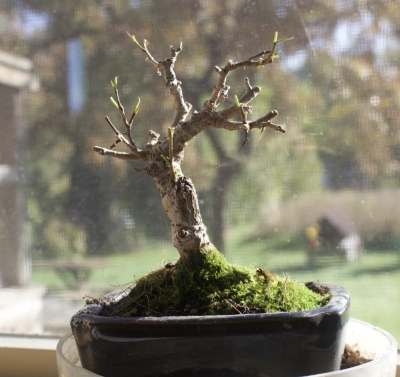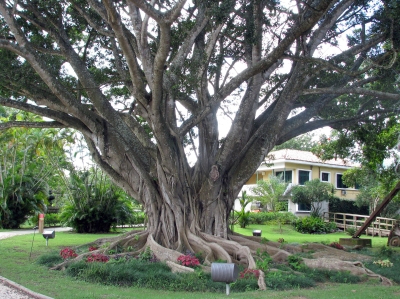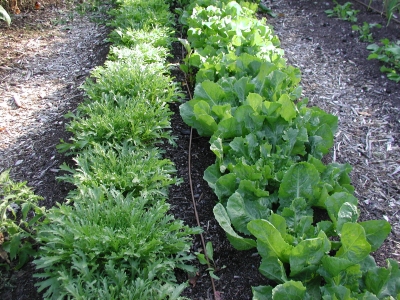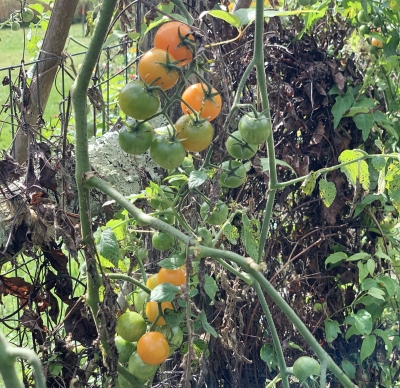MY FIG GROWS OLD, AND LOOKS IT
/2 Comments/in Houseplants, Pruning/by Lee ReichWeeping Fig, Growth in Check
My little fig tree put on a lot of new growth this year. Let me qualify this statement. By “fig,” in this case, I mean my weeping fig (Ficus benjamina). It’s a relative of edible fig, also edible (but rarely eaten), and a common houseplant, valued for its relaxed appearance, its small, glossy green leaves, and its tolerance for indoor environments. By “a lot of new growth,” I mean a half an inch or so.
Despite that meager growth, the plant has grown too large. Nothing like it would have grown outdoors in open ground in the tropics, where this trees’ branches quickly soar skyward and sideways to the size of our sugar maples. From those branches drip aerial roots which anchor themselves in the ground, the ones nearest the trunk eventually merging together to become part of a fattening trunk.
My little fig, you probably guessed by now, is a bonsai. The tree, if I may call a four-inch-high plant a “tree,” began life here as one of a clump of what evidently were rooted cuttings in a small, plastic pot I purchased on impulse from a big box store.
Back here at the farmden, I got to work on it, first teasing the plants apart from each other, selecting one as keeper. The road to bonsai-dom began as I trimmed back the roots to be able to fit the plant into its new home, a 3 by 4-1/2 inch shallow pot about an inch deep. There was little to prune aboveground, but I made any cuts necessary, with the future in mind.
AN AUTUMN VEGETABLE FROM FRANCE, FROM BELGIUM, OR IS IT BATAVIA?
/4 Comments/in Gardening, Vegetables/by Lee ReichSaying It is Easy; Naming It, Not so Easy
Pinch your nose with your fingers and say “on.” Follow that with a long, drawn out, “d-e-e-e-e-v,” your mouth in a smile to get emphasis on the e’s. Endive. I once considered endive to be lackluster in flavor, so needed to be offset with this highfalutin pronunciation. After many years of growing endive, I’ve come to recognize a more distinct flavor, nutty and just slightly bitter.

Endive, frisee & escarole
(This is the first time I’ve used “nutty” to describe a flavor, having recently figured out what it means. Nut-like. Duh. Hints of nuttiness are found in the flavors of many foods, including seeds, wines, beans oils, cheeses, fish, and, of course, almonds, hazelnuts, and other actual nuts. Since writing the above description of endive flavor, I learned that others have also described its flavor as nutty. QED)
TOMATOES & CORN, TWO ALL-AMERICANS
/3 Comments/in Planning, Vegetables/by Lee ReichOde to Sungold
As the curtain closes on the summer garden and the autumn garden edges towards its glory, I’d like to offer thanks. No, not a religious thanks for a summer of tomatoes, peppers, cucumbers, okra, and other warm weather vegetables. But thanks to a person, the person who bred Sungold cherry tomato.
Anyone not familiar with Sungold tomato should be. It’s sweet and tangy, not at all cloying, enveloped in persimmon-orange skin. I once grew over 20 varieties of cherry tomatoes (Solanum lycopersicum var. cerasiforme), including Sungold, for a magazine article. As a friend walked down the row, sampling fruit from each plant, she proclaimed, “That’s one row of lousy tomatoes.”
Agreed, excepting a few varieties, one of which was, of course, Sungold. The other exceptions were Gardener’s Delight, Sweet Million, and Suncherry, all three of which are rarely seen these days, probably because Sungold eclipsed the others with its distinctive appearance and, I think, even better flavor.
(My cherry tomato row didn’t include marble-size, so-called currant tomatoes, botanically, S. pimpinellifolium. They are very sweet, very small, and very tasty. I don’t grow them anymore because, for me, they’re too messy, dropping fruits all over the place. The following year, seedlings can grow to become a tomato jungle.)

